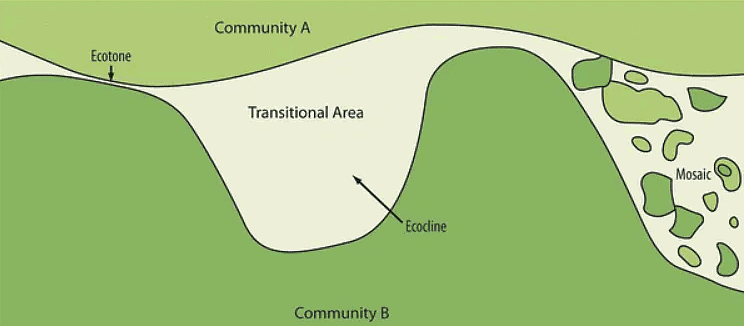Biosphere: Ecotones | Zoology Optional Notes for UPSC PDF Download
| Table of contents |

|
| Ecotone - Understanding the Concept |

|
| Characteristics of Ecotones |

|
| Ecotone Vs. Ecocline |

|
| Significance of Ecotones |

|
Ecotone - Understanding the Concept
An ecotone is a transition zone where two or more diverse ecosystems come into contact. It exhibits features of both adjacent communities and often harbors species not found in either of the adjoining ecosystems. Ecotones can also occur in aquatic environments, such as estuaries and lagoons, and in areas where water meets land, like marshes.
 Ecotone
EcotoneThese transition zones are characterized by the presence of large plants rooted in submerged substrates, and they thrive where sufficient light penetrates to support their growth.
Notable examples include mangrove forests, grasslands, estuaries, and riverbanks.
Formation of Ecotones
Ecotones can emerge due to changes in the physical environment, creating distinct boundaries between ecosystems. They may also form in mountainous regions as a result of varying climatic conditions on different slopes. These transitions often act as borders for different species due to the topographic features of the terrain. For instance, Mont Ventoux in France serves as a dividing line between the vegetation and wildlife of northern and southern France.

Wetlands, by nature, are often ecotones, arising from disturbances like landslides, shifts in the earth's surface, or sediment movements, leading to the formation of patches and ecotones within vegetation areas.
Characteristics of Ecotones
Ecotones possess characteristics that bridge the neighboring ecosystems, and their width can vary from narrow to relatively wide. This transitional zone represents a dynamic interface, often referred to as a "zone of tension." It exhibits a linear shift in species composition, with an increase in species from one community and a decrease in species from the other.
- Well-developed ecotones host species distinct from those found in the adjacent ecosystems.
- The edge effect is a phenomenon observed in ecotones, where the number of species and population density of certain species can be significantly higher than in either adjacent community.
- Birds, especially, exhibit this edge effect in terrestrial habitats, leading to higher population densities in mixed habitats.
Ecotone Vs. Ecocline
The concepts of ecotones and ecoclines are essential for understanding ecosystem variation within a specific geographic area. Both are influenced by genetic shifts in species and the need for adaptive characteristics.
 Ecotone Vs EcoclineHowever, there are distinct differences:
Ecotone Vs EcoclineHowever, there are distinct differences:An ecocline represents a specific new zone formed by the convergence of two similar ecosystems, while an ecotone indicates a gradient shift in physicochemical features between two ecosystems.
Ecocline transitions are less distinct, feature more stable conditions, and exhibit a higher diversity of plant species.
In contrast, ecotone transitions are more pronounced, conditions are less stable, and species diversity is lower.
Significance of Ecotones
Ecotones hold ecological significance in various ways:
They provide mobile animals with access to multiple habitats in close proximity, expanding their options for food and shelter.
Ecotones facilitate gene flow between populations, increasing genetic diversity.
They can act as buffer zones, protecting ecosystems along the border from harm. For example, wetlands can absorb pollutants, preventing them from entering rivers.
Conclusion
Ecotones are pivotal to understanding environmental dynamics and have substantial evolutionary relevance. These transition zones foster gene flow, leading to unique adaptations and variations. They also serve as sensitive indicators of climate change, as shifts in ecosystem boundaries are attributed to climate change. Ecotones are now a subject of extensive study by scientists and environmentalists, contributing to our understanding of the evolving natural world.
|
181 videos|346 docs
|

|
Explore Courses for UPSC exam
|

|

















